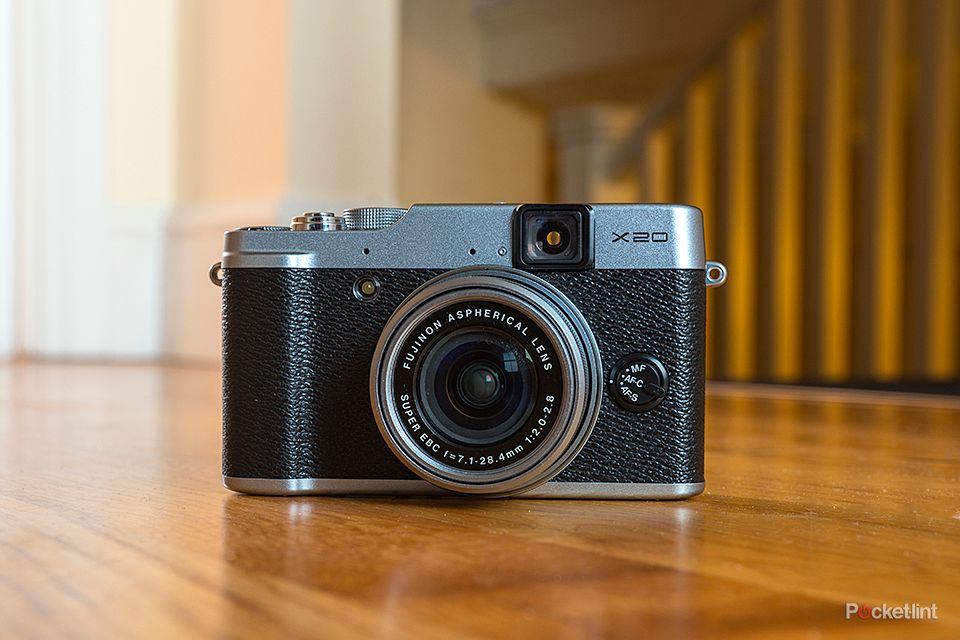The shiny loveliness that is the Fujifilm X20 was delivered to Pocket-lint this week, and we've since set about - in the chilly UK snowfall, no less - snapping away some initial shots to see how this high-end compact performs.
We'll save all the main meat for our forthcoming full review, but having used the X20 for half a day we can confirm that it's as much - if not more - of a pleasure to use as its X10 predecessor was. It's all retro-styled silver with chunky knobs and dials and a traditional twist-barrel 28-112mm f/2-2.8 equivalent zoom lens.
READ: Fujifilm X10 review
The wide aperture makes for wonderful shallow depth of field when paired with the 2/3-inch-size, 12-megapixel sensor, which is larger than found in most similar competitor models at this price point, save for the Sony RX100.
The X20's new sensor also has a special trick up its sleeve, as pinched directly from Fujifilm's own top-flight tech, namely its X-Pro1 compact system camera. The X20's 2/3-inch size X-Trans CMOS II sensor has - in addition to a rather silly name - done away with the low-pass filter in favour of Fujifilm's proprietary colour array system. This means no anti-aliasing softens the image for processing purposes and, therefore, means sharp images beyond its medium sensor size are possible. From what we've seen we've got to agree - just check out the crisp ISO 100 sample shot below, shown cropped to actual size (click for full-size image):
We've been shooting up and down the ISO 100-3200 sensitivity range to see how the X20 handles low light and, in general, it's a success. However, we have noticed a rather steep rise in JPEG artefacts from around the ISO 400 mark and above, so the top-notch quality does have a rather steep curve off.
All our JPEG shots have been taken at the default Fine setting - we've not adjusted the Color, Sharpness, Highlight Tone, Shadow Tone or Noise Reduction options within the menu for this particular set of shots. It's great to have such options on board for fine-tuning to personal preference though - something we'll be digging deeper into as we get to grips with the camera.
The X20 can also capture raw files which, without noise reduction processing applied, show up an extra lick of sharpness at the lowest ISO settings - particularly ISO 200 - but this dwindles into rather considerable image noise as the ISO sensitivity rises. While the ISO 1250 sample shot of flowers above looks marvellous at this scale, click the image for a 100 per cent crop of the raw file where its far noisier version is revealed.
Further up the sensitivity scale we found that ISO 3200 does show off some image noise, as is to be expected, but it's a fair sight better than plenty of other high-end compact cameras.
The raw files also reveal some clever JPEG processing that corrects for chromatic aberration, namely the subtle purple fringes that can be visible to subjects' edges, alongside some colour, contrast and other tweaks. While we love the subtle background blur that highlights the heron in the shot below, the full-scale image does reveal some of these mentioned minor imperfections - click the image to take a look at a section of the original raw file:
Blurred background gets even more amplified in the X20's macro mode - which is divided into standard and Super Macro options. Both work incredibly close to the lens, right down to a mere 1cm from the lens at the widest-angle 28mm equivalent. The lens is sharp too; shots at those lower ISO settings look crisp and striking to our eyes. Combine that with the wide-open aperture and it's top notch stuff.
Quality-wise the previous X10 model did raise some concerns with what many called the "white orb" fiasco - a processing issue that caused specular highlights to morph into white orbs. Is it a presence in the X20? From what we've seen so far, not at all - which we'll put down to the brand new sensor. Of course we'll be shooting and looking at bundles more X20 shots over the coming days to see how the camera holds up, but we're confident at that stage that it's looking good.
Add an optical viewfinder with a new digital overlay to confirm focus point, aperture setting and shutter speed and - despite the same 85 per cent field of view as per the X10 - it's otherwise not just image quality that's on the up, it's usability too; the whole shebang.
Indeed the X20 looks to be among the top high-spec compact cameras to beat in 2013, yet for a pound shy of £500 we were hoping it would impress. It might be top dollar, but it's top drawer too: each cent of that cash investment goes into a sound product from what we've seen.
We'll be bringing you our full Fujifilm X20 review in the coming days, so keep your eyes locked to Pocket-lint.

